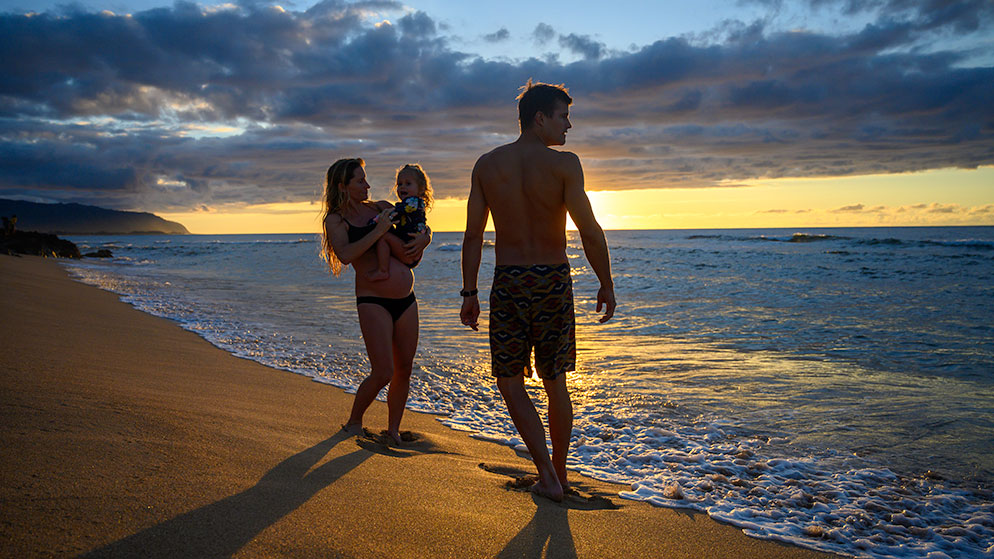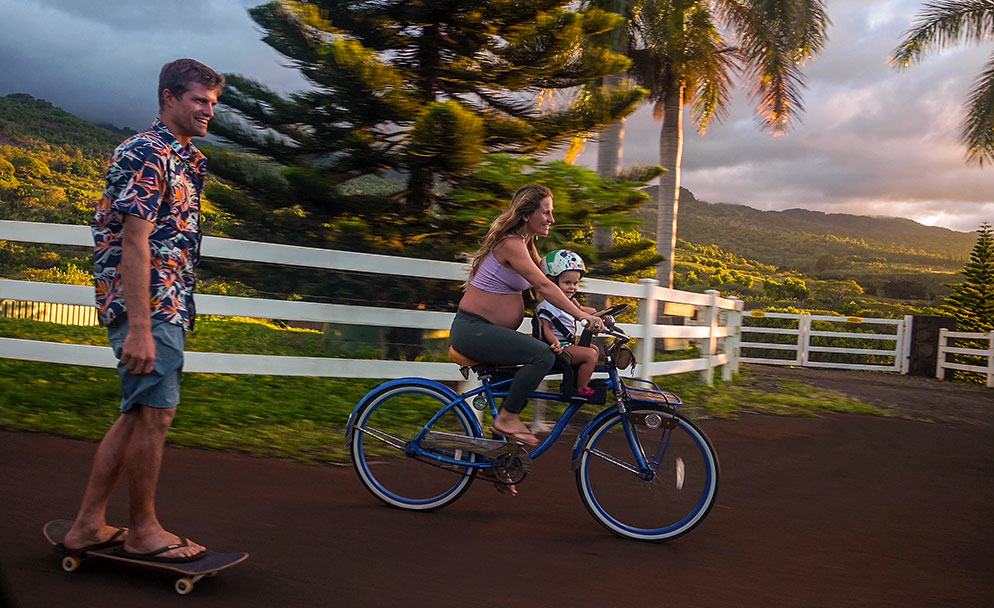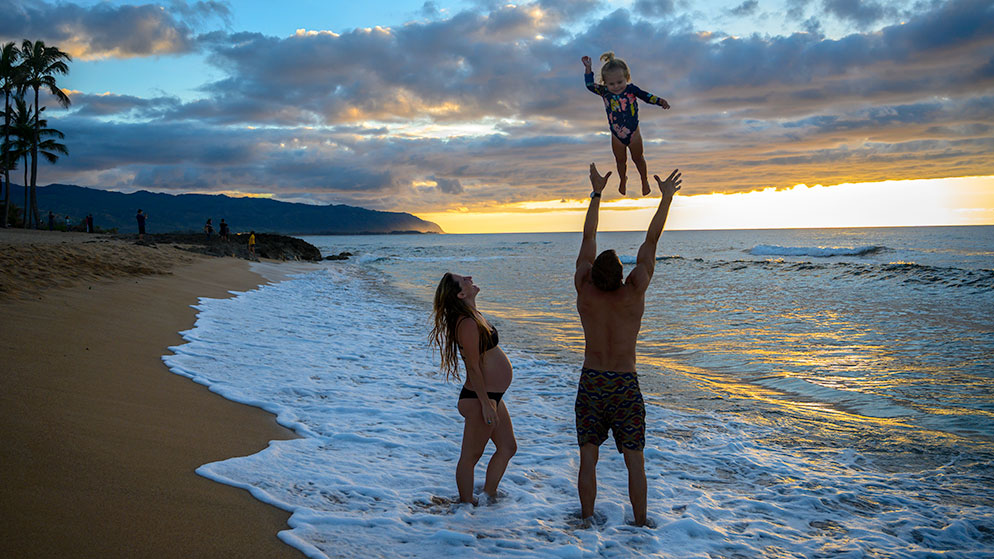Creative Storytelling with the Z 6 Filmmaker's Kit
Small Footprint - Casey, Shae and their daughter, Swede living off the grid, on the north shore of Oahu, Hawaii.
Images, whether stills or video, are stories. It's as basic as that.
Our story here is about the Z 6 Filmmaker's Kit, and how you can use it for the stories you are inspired to tell.
And we mean you. Not "you and a crew," not "you and a truckload of gear," and not "you and a production army." We mean you can choose to go solo and be able to create a sophisticated, pro-quality video—like Small Footprint, the video Deanne Fitzmaurice made when we asked her to tell a story that would highlight the kit's capabilities.
The Z 6 Filmmaker's Kit includes the Z 6 camera, the NIKKOR Z 24-70mm f/4 S lens and our Mount Adapter FTZ; plus a hand-held camera stabilizer for smooth shooting; a shotgun microphone for quality audio recording; a super-bright, five-inch recorder/monitor to view and record uncompressed high-resolution video; and a few other goodies to put you in control of creative filmmaking options. Deanne also brought along a Z 7.
The story of Deanne's video includes...well, read on.
Hawaiian Eyes
The thing about stories is that one often leads to another.
Deanne, a Pulitzer Prize-winning photojournalist and a Nikon Ambassador, met the Goepel family—Casey, Shae and their daughter, Swede—when she taught a workshop a while back on the north shore of Oahu. The subject of the workshop was "developing a story."
It was a one-day session, but the Goepels made an impression.
"I was fascinated with them as people," Deanne says, "and I thought, What a story they have—surfers, largely living off the land, choosing their own lifestyle. I'm always interested in cultural stories, stories of how people live. I keep an ongoing story list of ideas and hopes for future stories, and I put them on it."
Then along came the Z 6 Filmmaker's Kit and Nikon's idea of Deanne shooting a film, and all the elements came together perfectly as Deanne saw the instant connection: the film would be called Small Footprint, for the Goepel's lifestyle, and it would in fact be a small-footprint production made possible by the filmmaker's kit and Deanne's preference of independent, documentary-style photojournalism.
Deanne got the Goepel's cooperation, enlisted a friend, producer Lisa Fraser, to help with the production and headed to Hawaii.
A screen grab from the video's bike sequence, for which Deanne had the NIKKOR Z 24-70mm f/4 S on the Z 6. The stabilizer kept it smooth; Casey's skateboard kept it real.
Being There
Deanne had only four days for filming, and to take full advantage of the time she decided to stay with the family in one of their eco-rental lodges. "We were looking for the spontaneous moments," she says, "so staying with them meant we'd be there at six in the morning and well into the evening, with our equipment, ready to start filming if we saw that things were happening. We got to be a part of their lives in that sense—they were relaxed, they knew my style and my approach. I didn't really direct them, I just kind of let things unfold. It was, Okay, what are you going to be doing today?—that kind of thing, and then just let it happen."
One of the things that happened was hoped for, but still unexpected. Shae had mentioned wanting to swim with the dolphins while pregnant with her second child. "That got my attention," Deanne says, "and I was hoping it would happen. It was cinematic, that's for sure, and it was important to Shae, as she'd done it with Swede. And this was the time of year the dolphins came close to the shore."
It's possible it happened because Deanne and Lisa were there. They noticed the dolphins on an early-morning swim. "We couldn't see them, but we heard them—there was this squeaking coming up from below us. Then as we packed up to leave the beach, we looked out and saw all these fins in the water—dolphins!"
Shae and Casey couldn't make it to the beach, but they all tried again the next day and got what they'd hoped for. "There were probably fifty to a hundred dolphins in the water," Deanne says. "I'd brought the KeyMission 170 with me to Oahu, thinking of maybe some underwater filming of the family surfing, and I gave it to Casey and he went into the water with his snorkel and fins and got the footage we'd hoped for. The dolphins came close, and one of them came so close to Shae that it seemed to know something was up."
Deanne had come to the island with a rough shot list—the family surfing, holding the yoga classes, taking fruit off the trees—and the expectation of strong visuals of the north shore of Oahu. "We were trusting things would happen and we'd get what we wanted and needed, and we were always hoping for the unpredictable. Getting the story was about getting into the feeling and rhythm of their lives for this short time. That's the way I work—you plan what you can, do what you can, trust in the rest."
A toss-up on the beach with Shae, Casey and Swede. Z 7, NIKKOR Z 24-70mm f/4 S, 1/1000 second, f/4, ISO 800, manual exposure, 3D Color Matrix metering.
The Kit's Contribution
The main ingredients were, of course, the Z 6 itself and the lenses she chose for it. "I used the NIKKOR Z 24-70mm f/4 S a lot, and it's great," Deanne says. "With the FTZ adapter I used the AF-S NIKKOR 200-400mm f/4G ED VR II for the surfing scene and the AF-S NIKKOR 85mm f/1.4G for portrait-type shots."
The stabilizer (Moza Air 2 3-Axis Handheld Gimbal Stabilizer is the complete proper name) insured smooth footage for several key scenes. "It's like a gyro," Deanne says, "and I used it during the bicycle scene, where Lisa is driving the car and I'm in the back seat hanging out the window. There were all these bumps in the road and the camera's going up and down, but the stabilizer just smooths it all out so you see a nice steady shot of them. And I was also holding it to steady the shot as I'm walking by in the yoga scene."
The Røde shotgun mic saw a lot of service—"I just set it in the hot shoe and it did a great job for improved audio"—and the Ninja recording monitor (full name: Atomos Ninja V 4K Recording Monitor) gave a "great view" of what she was recording, as well as provided uncompressed video quality when it came time to edit the footage.
They key to getting the most from the accessory items in the kit was to take the time prior to the shoot to become familiar with how they worked and exactly what they'd do. It wasn't a steep learning curve, just an essential step. "I spent some time with the kit at home," Deanne says, "and most of it was straightforward and intuitive. The Moza and the Ninja had a little learning curve. The thing about the stabilizer is setting its balance to suit the weight of the lens you're using."
For those interested in or just curious about the Z 6 Filmmaker's Kit, select Nikon dealers are currently offering rentals of the kit, including one deal that'll put it all in your hands for three days for about a hundred dollars. We may be a little biased here, but If you can think of more creative fun, let us know.









